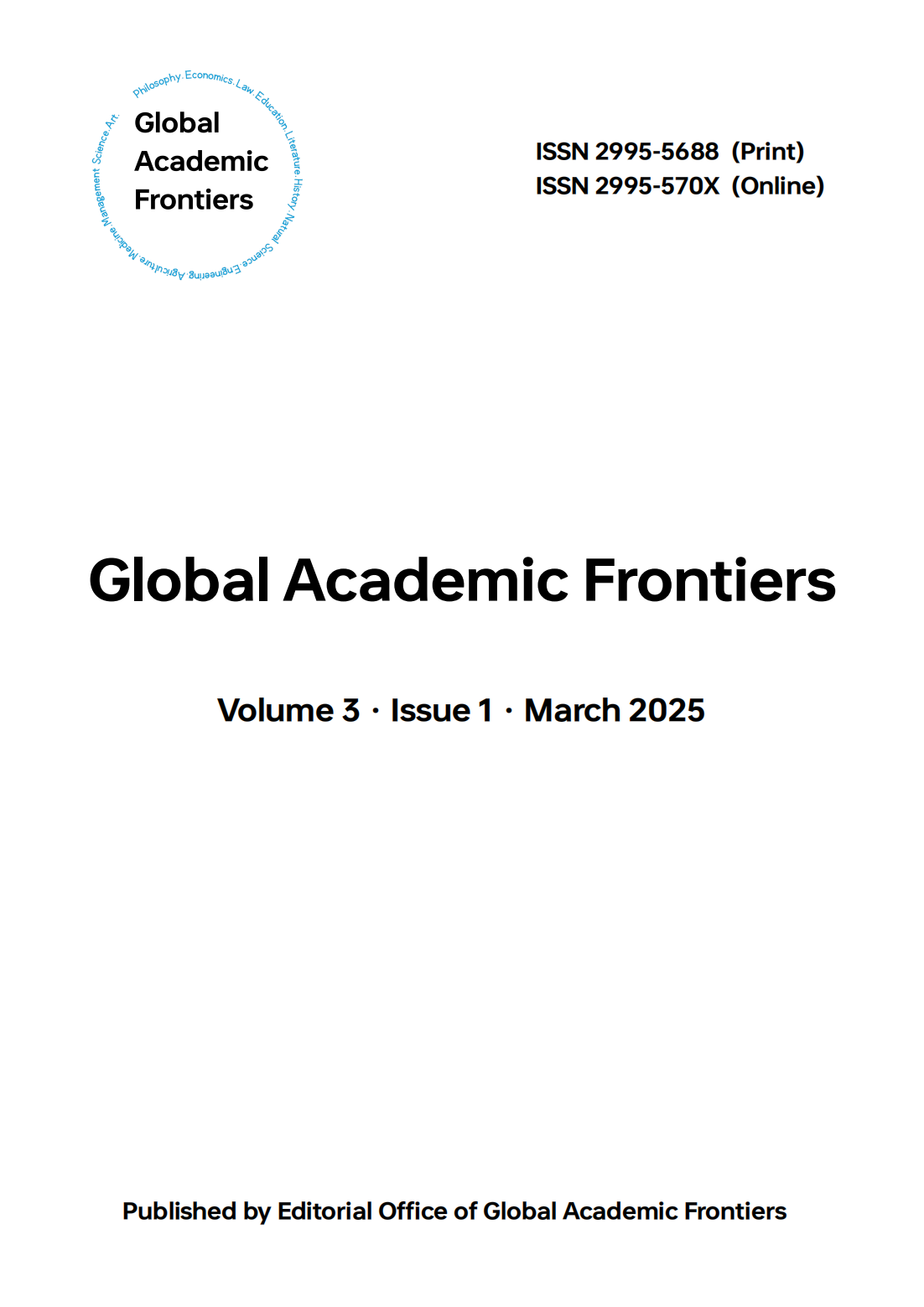Genetic Modification Technology and Food Security: Opportunities, Challenges and Response Strategies
DOI:
https://doi.org/10.5281/zenodo.15074505Keywords:
Genetic modification technology, Food security, Gene editing, Ecological risk, International cooperationAbstract
Against the background of global population growth, climate change and the increasing tension of arable land resources, how to ensure food security has become a major issue that needs to be addressed by the international community. As an efficient and precise means of genetic modification, transgenic technology has demonstrated remarkable potential in increasing crop yield, enhancing stress resistance and optimising nutritional quality. However, the large-scale application of this technology is still faced with scientific risks such as genetic drift and ecological balance disruption, as well as multiple challenges such as divergence of public opinion, ethical controversies, and lack of regulatory systems. Based on systematic literature research and case study analysis, this paper firstly compiles the major bottlenecks facing global food security and points out the shortcomings of traditional agricultural technologies in coping with extreme environments and resource scarcity; then it elaborates on the principles and successful practices of biotechnologies such as genetic modification and gene editing, and explores the advantages and constraints of these technologies in increasing agricultural yields and sustainable development; finally, it raises questions from the dimensions of technological research and development, public education, law and regulation, and international co-operation. Finally, the study proposes strategies in the dimensions of technology research and development, public education, law and regulation, and international co-operation, and emphasises the importance of multi-party collaboration and long-term monitoring to ensure the safe application and social acceptance of GM technology. The results of this study provide useful references for relevant policy makers, research institutions and the public to understand the opportunities and challenges of GM technology, and lay a theoretical and practical foundation for further improving the food security governance system and achieving the goal of global poverty reduction.
Downloads
References
Food Security Information Network (FSIN), & Global Network Against Food Crises (GNAFC). (2024). GRFC 2024. Rome. Retrieved from https://www.fsinplatform.org/report/global-report-food-crises-2024/
International Service for the Application of Agricultural Biotechnology(ISAAA),(2021).Global biotechnology/transgenic crop commercialisation dynamics in 2019. Chinese Journal of Bioengineering, 01, 114-119. https://doi.org/10.13523/j.cb.2012100
IPCC. (2023). Climate Change 2023: Synthesis Report. Geneva, Switzerland: IPCC. https://doi.org/10.59327/IPCC/AR6-9789291691647
Rezaei, E.E., Webber, H., Asseng, S. et al. Climate change impacts on crop yields. Nat Rev Earth Environ 4, 831–846 (2023). https://doi.org/10.1038/s43017-023-00491-0
Wang, S., Bai, X., Zhang, X. et al. Urbanization can benefit agricultural production with large-scale farming in China. Nat Food 2, 183–191 (2021). https://doi.org/10.1038/s43016-021-00228-6
Andorf, C., Beavis, W.D., Hufford, M. et al. Technological advances in maize breeding: past, present and future. Theor Appl Genet 132, 817–849 (2019). https://doi.org/10.1007/s00122-019-03306-3
Pratiksha, P., & Sharma, P. (2020). Status of Environmental Pollution in Rural Punjab and its Management. International Archive of Applied Science and Technology, 11(4), 98-104. https://doi.org/10.15515/iaast.0976-4828.11.4.98104
Yao, Z. P., Cheng, Y., Wan, H. J., et al. (2017). Application of CRISPR/Cas9 genome editing technology in plant genetic engineering breeding. Molecular Plant Breeding, 15(7), 2647-2655. https://doi.org/10.13271/j.mpb.015.002647
U.S. Department of Agriculture, Economic Research Service (USDA ERS). (2024). Adoption of Genetically Engineered Crops in the United States - Recent Trends in GE Adoption. Retrieved from https://ers.usda.gov/data-products/adoption-of-genetically-engineered-crops-in-the-united-states/recent-trends-in-ge-adoption.aspx
Krishak Jagat. (2024, October 2). The Journey of Bt Cotton in India: A Historical Overview and its Impact on Agriculture. Retrieved from https://www.en.krishakjagat.org/india-region/the-journey-of-bt-cotton-in-india-a-historical-overview-and-its-impact-on-agriculture/
Khan, S., Anwar, S., Yu, S., Sun, M., Yang, Z., & Gao, Z. Q. (2019). Development of Drought-Tolerant Transgenic Wheat: Achievements and Limitations. International journal of molecular sciences, 20(13), 3350. https://doi.org/10.3390/ijms20133350
Mallikarjuna Swamy, B.P., Marundan, S., Samia, M. et al. Development and characterization of GR2E Golden rice introgression lines. Sci Rep 11, 2496 (2021). https://doi.org/10.1038/s41598-021-82001-0
Ofosu, R., Agyemang, E. D., Márton, A., Pásztor, G., Taller, J., & Kazinczi, G. (2023). Herbicide Resistance: Managing Weeds in a Changing World. Agronomy, 13(6), 1595. https://doi.org/10.3390/agronomy13061595
Bruce E Tabashnik, Jeffrey A Fabrick, Yves Carrière, Global Patterns of Insect Resistance to Transgenic Bt Crops: The First 25 Years, Journal of Economic Entomology, Volume 116, Issue 2, April 2023, Pages 297–309, https://doi.org/10.1093/jee/toac183
Kranthi, K.R., Stone, G.D. Long-term impacts of Bt cotton in India. Nat. Plants 6, 188–196 (2020). https://doi.org/10.1038/s41477-020-0615-5
Mou, W.Y., Jia, Yifan, Zhao, Zongchao, Guo, W.V. & Chen, F.J.. (2016). Research progress on the risk of exogenous gene drift in transgenic crops and its control technology. Journal of Ecology (01), 243-249. doi:10.13292/j.1000-4890.201601.033.
Sikora, D., & Rzymski, P. (2021). Chapter 13 - Public Acceptance of GM Foods: A Global Perspective (1999–2019). In P. Singh, A. Borthakur, A. A. Singh, A. Kumar, & K. K. Singh (Eds.), Policy Issues in Genetically Modified Crops (pp. 293-315). Academic Press. https://doi.org/10.1016/B978-0-12-820780-2.00013-3
National Academies of Sciences, Engineering, and Medicine. (2016). Genetically engineered crops: Experiences and prospects. Washington, DC: The National Academies Press. https://doi.org/10.17226/23395
Granieri, M. (2016). Genetically Modified Seeds, Intellectual Property Protection and the Role of Law in Transnational Perspective. In: Bellantuono, G., Lara, F. (eds) Law, Development and Innovation. SxI - Springer for Innovation / SxI - Springer per l'Innovazione, vol 13. Springer, Cham. https://doi.org/10.1007/978-3-319-13311-9_6
World Trade Organization. (1994). Agreement on Trade-Related Aspects of Intellectual Property Rights (TRIPS Agreement). Geneva: WTO.
Peshin, R., Hansra, B. S., Singh, K., Nanda, R., Sharma, R., Yangsdon, S., & Kumar, R. (2021). Long-term impact of Bt cotton: An empirical evidence from North India. Journal of Cleaner Production, 312, 127575. https://doi.org/10.1016/j.jclepro.2021.127575
Kumar, K., Gambhir, G., Dass, A. et al. Genetically modified crops: current status and future prospects. Planta 251, 91 (2020). https://doi.org/10.1007/s00425-020-03372-8
Chen, X. J., He, S. L., Cheng, K. L., et al. (2003). Impact of transgenic Bt insect-resistant rice on the biological community of paddy fields. Journal of Sichuan Agricultural University, 21(2), 185-186.
CHEN Chuan-Yong, ZHAO Jiuran, WANG Yuandong, WANG Ronghuan, XU Tianjun, LV Tianfang... & Cheng, Guanglei. (2018). Effects of nitrogen fertilizer reduction on nitrogen efficiency and yield of Jingke 968 and Zhengdan 958. Maize Science (03), 121-127. doi:10.13597/j.cnki.maize.science.20180320.
State Council of the People's Republic of China. (2001). Regulations on Administration of Agricultural Genetically Modified Organisms Safety (Decree No. 304). Retrieved from https://faolex.fao.org/docs/pdf/chn52814E.pdf
Downloads
Published
Issue
Section
License
Copyright (c) 2025 Yi Hu, Ye Chen (Author)

This work is licensed under a Creative Commons Attribution 4.0 International License.






